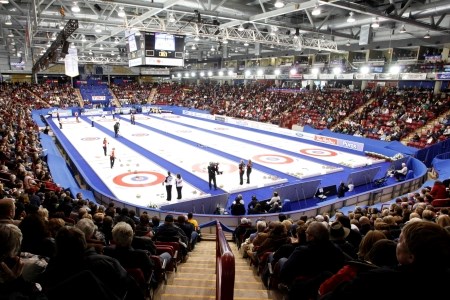With sports tourism growing from a niche market to a multi-billion dollar global business through events like the FIFA World Cup in South Africa, it stands to reason that smaller cities like Sault Ste. Marie want a piece of the pie.
“The city has a long history of hosting major sporting events,” said Ian McMillan, Tourism Sault Ste. Marie’s executive director, in mentioning the 1990 Brier, 1993 Memorial Cup and the 2010 Scotties Tournament of Hearts.
McMillan said the local hospitality and strong volunteer base always has national organizers saying their Sault experience was “one of their best events ever.”
The opening of the downtown Essar Centre in 2006 as a multi-purpose venue has given tourism officials an important card to play in attracting even more events.
In any given year, the Sault hosts between 70 and 100 conferences, conventions and sporting events, bringing in as many as 14,000 delegates and generating about a $10-million impact. It’s led to the creation of a coordinator of special projects and sports tourism within the department, filled by Steve Hollingshead.
With 13 years experience in event management with Elliot Lake’s NorDev Group, Hollingshead works with local sports associations in putting together bid packages. He assists with promotional material, writes funding proposals, shepherds groups through the staging process, secures hotel partners and venues, and basically helps them get the most economic bang for their buck.
Hollingshead laughs when asked what size of event works well for Sault Ste. Marie.
“That’s an open question.”
He points to the city landing the 2012 Carha Hockey Cup, considered the world championship of recreational hockey, for a week-long event running March 4-11, 2012. It will be the largest the city has ever hosted.
The Sault successfully bid against Toronto in the final shortlist.
“It’s way above and beyond what Sault Ste. Marie and Northern Ontario has ever done. We managed to do the impossible and win that bid.”
Held once every four years, the event has grown to host as many as 167 teams.
“We’re really showcasing Sault Ste. Marie to the world.”
What it means for the Sault is an estimated 2,500 participants arriving from 11 countries and booking up the city’s 1,600 hotel rooms.
Some local hoteliers have made extensive renovations in anticipation of the event.
Now it’s about pulling the pieces together, said Hollingshead.
“Every event is an event within itself. For every hockey tournament there’s a banquet, trade show and some kind of grandstanding event.”
The tournament could spill over into outlying areas with entertainment activities being planned to show off what Northern Ontario has to offer. “We have to be ready to blow them away,” said Hollingshead.
The tournament should raise local expectations for going after large events. “We have the facilities, the volunteer base, the hospitality, including the transportation.”
The city is working with a major airline to run charter flights from Toronto to airlift the participants in over a two-day period.
Event hosting is gaining more traction with local tourism officials.
Hollingshead’s annual budget was recently boosted from $20,000 to $100,000 to help local groups offset their expenses in hosting conferences and in booking local venues.
Hollingshead said he’s working on four events for 2011, including an Ontario colleges men’s basketball championship next March, a northeast regional ringette tournament
in April and the Hap Ki Do Canadian Open, an international martial arts tournament, in August.
Besides renovations at local hotels, a longstanding tourism asset is also getting a long overdue upgrade.
The Agawa Canyon tour train is getting a $10-million facelift with 14 coaches being sent to a refurbishment shop in St. Louis.
The passenger cars will be outfitted with new wheels, better seating, larger windows, GPS-triggered headsets providing commentary in five languages, and TV views from a digital camera mounted at the front of the train.
The one-day excursion attracts almost 30,000 visitors annually.
However, a future tourism asset still remains in limbo. Finding a developer for the city’s vacant waterfront Gateway site has been a garden of agony since the late 1990s with a succession of contenders and pretenders proposing a variety of big-box attractions.
Because of the fragile economy, the city has downsized its ambitions for the 14-acre property. McMillan said any future development must be a mixture of a “unique and compelling” attraction that will draw travellers across the International Bridge but also encourage locals to visit multiple times.
“That’s what going to keep the turnstiles turning and cash flow going to sustain the operation,” said McMillan. “You have to be cognizant that there are very few tourist attractions that make money.”
A new business plan with the “best bet opportunities” for a public-private Gateway partnership hits city councillors later this fall.
www.saulttourism.com




